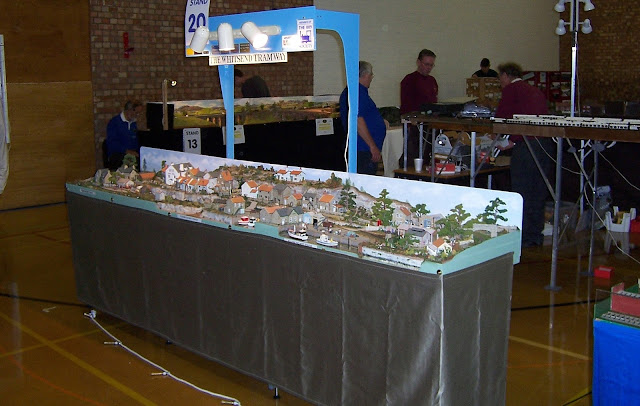THE WHITSEND TRAMWAY - 2006
(14th layout)
"Liassic" at "Two Bridges".
After a couple of visits to the North York Moors coast, Whitby, Robin Hood's Bay and Runswick Bay area, I had become attracted to the lovely village structures, and watching "Heartbeat" on TV every week made me even more interested in the area and it's atmosphere. So, when considering a new layout to replace "Carne", it was this region I wanted try to model.
The standard gauge along this part of the coast ran at a high level around and along cliff tops, but I just wanted to try to model and run a fictitious tramway around a village, trying to capture the 1960's atmosphere, colours and buildings (but altogether in reality it would be a very unlikely scene).
I knew the general scheme I wanted, but my plans shifted as I built the layout, and I found out how difficult it is to get enough space to model a proper "roadside tramway" on small boards. There were three of them 1m x 575mm (39.5" x 22.5") making the layout just under 10ft long. In the end, the "road" became a small lane through the village, and the tramway ran on a right of way all of it's own.
(Click on images to enlarge)
(Click on images to enlarge)
The Royal Hotel, and grocers shop in the village. The Royal Hotel is from Runswick Bay and the shop building from Robin Hood's Bay.
The boards were arranged end to end, and the track plan had a continuous run with a hidden fiddle yard underneath a small cliff at the back of the centre board. So, most of the elongated "oval" was visible to onlookers with the trains running in front of, and behind the village buildings and into the fiddle yard. The layout featured a small station with passing loop, quayside siding, engine shed and small carriage shed, and a halt. There were 32 buildings including a farm, various cottages, the Hotel, a shop, chapel, tea shop, harbour masters office, a garage, fish sheds and a life boatman's institute. Some of the buildings were models of actual structures (from my own photographs of frontages only though) or generic vernacular buildings from modified kits. Methods of construction varied from scratch built items to simply re-painted Skaledale buildings.
VIDEO
With the rock surface and ground colour, I tried to replicate the areas "tones" from photographs, and I used some Heki Rock Foil embossed rock face material and cork bark as a basis, dry-brushed with appropriate greys and browns.. Walls were re-painted Peco Model Scene Stone Walls and Buttresses. Trees were made from Woodland Scenics Tree Armatures painted and with added Foliage material.
The whole layout just before an exhibition opened.
Plan
Turnout control was by simple wire-in-tube. This layout, and "Carne" before, used a Trax Controls "Chuffer Module" for steam sound. The module and speaker were mounted in an old PC speaker unit and a separate pot was linked to the "synchronisation" adjustment so I could control the chuff speed to different locos.
The chapel was made using Wills materials. The actual Chapel in Runswick Bay, it is said, was built by the fishermen's wives while their husbands were out to sea.
The station building started life as a Wills Corrugated Iron chapel and the tea shop next door was a Taxi Men's Hut.
"Liassic" and tramway coaches run past the quayside.
Thorndale Halt was situated behind the engine shed and coach shed, quite hidden at the right hand end. Trains stopped here during exhibitions and onlookers often asked why the train had stopped!
"Luther" and passenger train pass the inner harbour. The two right-hand fishing boats were moulded resin ornaments from the Norfolk sea side, £2.99 each.
Tram loco "Lottie" and goods train at "Two Bridges".
The flags are out for the visit of Lorg Craig, here standing outside the Royal Hotel with the tramway's boss Sir Richard.
The Craig & Mertonford Railway's "Colin" and all three modified O.E.G coaches on their visit to Whitsend.
An article appeared for the Whitsend Tramway in the January 2008 Railway Modeller and in "009 News" June 2007.
Whitsend was exhibited 44 times and was sold in 2016.
Whitsend was exhibited 44 times and was sold in 2016.
















No comments:
Post a Comment